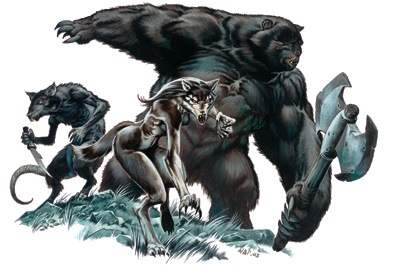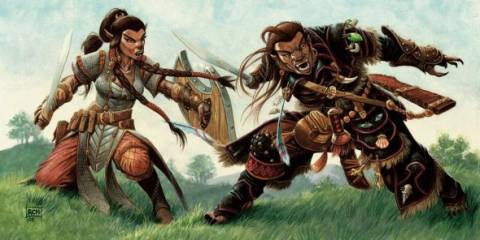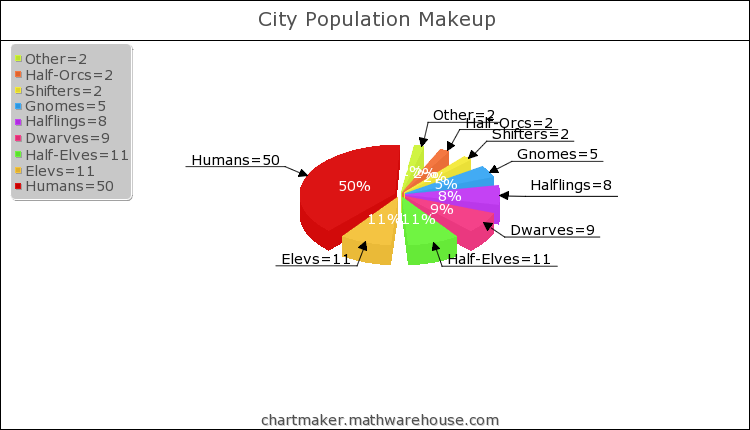Here we are again for episode 2 of creating a D&D campaign. You can find Episode 1 here. Edit: And now you can find Episode 3 here! And Episode 4 here! Go check it out after reading Episode 2, below.
Last time we left off talking about city and region history, so, I'll be picking episode 2 up about there and try to answer a couple of more questions about the city. I'll try to keep this episode a bit shorter than the first one. I'd rather have to have two more shorter ones that are more manageable to read through than one giant one again that probably most people don't want to trudge their way through.
So without further ado-
Creating A D&D Campaign: Episode 2! (I Have to Build This City Faster Than Rome)
Continuing With History

So, talking about city history, I've been mulling over some of the things I mentioned last time. I still sort of like the idea of using a sort of lycanthropy outbreak being the reasoning behind shifters as a race in my setting. I'd sort of like non-human races to be common in my city. I'll get into it later, but, most reference books regarding cities and city building for D&D tend to list even something like a "mixed race population" as being made up of upwards of 80% humans and all of the remaining races make up the last 20% or so, often with at least 1% being just undefined races; which in a 10,000 person population, 1% means there's only about 100 of that race within the city. But I'm getting side tracked, I'll get to city population makeup further on.
Back on track with history, I like the lycanthropy outbreak idea. I need to figure out, however, if this lead to any kind of war, if it was just an outbreak of the disease, how did the city/region deal with such a dangerous outbreak -
- Were the lycanthrope infected persecuted and kicked out of the city?
- Was a cure for the disease found and was it forced on many of the citizens, those desiring to not take the cure fleeing or trying to hide?
- Were most of them just killed off?
- How did the outbreak start and how did it stop?
- How have city laws and precautions been effected by this outbreak?
There's a lot of things to consider here. Lycanthropy is spread as a disease through being bitten by someone already afflicted with the lycanthropy disease. There are natural lycanthropes as well, who are born with the condition, but, for them it is not considered a disease, they consider it as more of a racial modifier (being a shapeshifter in addition to their normal type.) As for the disease version of lycanthropy, there are several ways to cure it, though most are not particularly easy.
- Ingesting a sprig of belladonna (aka wolfsbane) within 1 hour of being bitten gives the victim a chance (but only a chance) to prevent the affliction. Wolfsbane however is also toxic, meaning that eating it has a chance to cause serious harm to the victim (but at least they won't be afflicted by the disease, and the serious harm can also be only slight harm, or no harm at all, and is not permanent damage.)
- A remove disease or a heal spell cast on the victim within 3 days of being attacked, but the spell must be cast by a caster of at least 12th level (which, when you max out at level 20, 12th level is pretty high, and isn't always that easy to find.)
- Finally, a remove curse or break enchantment spell can also remove the disease, but, it can only be successful during one of the three days of the full moon, at any other time the spell has no effect at all. Even cast during the proper time, however, there's not a guarantee that the spell will be successful (though, unlike the other two options, this can be repeated at later times.)
So, with most of this in mind, this gives me a couple of ideas of where I may want to go with some of this.

- There will probably be a law in the city against lycanthropes, whether natural or otherwise, being forbidden/illegal/whatever word you want to use. Probably on pain of death, for fear of an outbreak happening again in the future.
- It probably started as a result of a cult of natural lycanthropes that wanted to "spread their blessing to the masses" (maybe they worshiped a god of some type that ties into that.)
- Afflicted lycanthropes during the outbreak were probably mostly killed at first, since they probably wouldn't have known what was going on or that they were really innocent people. In the more long term, I'm thinking I'm going to leave it hazy for now. I know that's a bit of a cop out, but, I need to get the bigger picture done ASAP and the details can wait; plus I picture this being one of the darker times in their history, they wouldn't want a lot of the details being passed on down through the generations.
- This would have happened at least several hundred years ago, but with races that live hundreds of years such as elves and the like being 'common' in a fantasy world, for them, even several hundred years ago wouldn't be 'that' long ago for them, although it would certainly be a long time ago for many of the other races.
- Maybe the elves know the truth behind much of what happened during the outbreak, and were the source of bringing the outbreak to an end, but it is something that they simply don't talk about.
- Belladonna may be a common sight in or around the city due to people being overly cautious from the past.
- At least one 'tribe' of peoples broke off from the city during the outbreak, lycanthropes that needed to flee from the city (whether due to persecution or in an attempt to do the right thing and distance themselves from innocent people) which is probably where shifters as a race came from.
- There is probably still some amount of superstition and/or fear regarding full moons and many citizens probably stay in doors on the nights of the full moon.
I think that covers everything that I'll start with on the matter, at least in regards to the lycanthropy idea.
As for the idea regarding ruins, I still want ruins to be 'a thing' in the campaign, but, I think the ruins will be more hidden than anything right now and will be fairly more 'mysterious' over all, so, I'm not going to worry about it right now beyond knowing that I want their to be hidden ruins in or around the city. I think I'll call it good at that for now, I may think of more stuff later, but, I can't spend too much time on the finer details here really, so, moving on!
Population Ratios!
So, I started touching on this some earlier, but, here we get into the nitty gritty of it. This will also probably be considerably more boring than any of the rest of the stuff since it's not overly important and is a lot of math stuff.

So, every city is made up of different races in different population numbers. As briefly mentioned before, most books/reference material assumes that races all sort of have their own cities and that in human cities, which are considered 'normal' or 'mixing pot' cities humans make up around 80% of the population. Let's take an example city from one of the books that has a population total of 18,680. The racial make up of the city is 80% humans (14,944 people), 8% halflings (1,494.4 people), 4% gnomes (747.2 people), 3% dwarves (560.4 people), 2% elves (373.6 people), 1% half-elves (186.8 people), 1% half-orcs (186.8), and 1% "other" (186.8 people.) Which means all of the rest of the races all together are still outnumbered by humans 4-1. And most of the source material is like this.
So, I have to decide if I want my city to be human based like most, and human dominated by such a large margin, or if I want this to be even more of a mixing pot of the races than "the norm." I don't mind humans being the largest single group of people in the city, but I'm really not that fond of them outnumbering the other races all combined by 4-1.
Either way, let's start by figuring out what races will be present in the city.
- Humans
- Elves
- Dwarves
- Gnomes
- Halflings
- Half-Elves
- Half-Orcs
- Shifters
- Other (there will certainly be other races that will take residence in the city, but, not in any appreciable number to be counted on their own by their own race.)
Humans will make up the majority of the population, but that means their percentage could be anything at 51% or more. Even below 50% they as a single race would take up more than of the percentage than any other individual race. I think I'll probably just put them at 50% and call it good for them. Should they maybe be greater than 50%? Maybe, but I can rationalize their lower numbers as a result of the lycanthropy outbreak dwindling the city's numbers by a considerable amount in the past and they're only slowly recovering from it while many other races moved in to help sort of re-stabilize the city after the outbreak.
Elves, if they helped put an end to the outbreak in the past may make up more the second largest population percentage. Or, they may be tied for it with Half-elves; more elves in a human city is bound to increase the number of half-elves over all, logically speaking. So I think elves and half-elves will tie for second place. I know that humans will be 50%, and I know past the elven races I'm still going to need six other percentages worked into the total. So let's put elves and half-elves at 11% each. Bringing us to 72%
Dwarves will be the next highest race, many having been brought in in the past to help rebuild the city after the destruction caused by the lycanthropes, and mountains and a mining town not being too far away from the city itself also helps boost dwarven population numbers for the trade city. Let's put them at 9% of the total population, bringing us up to 81% total.
Now we still have gnomes, halflings, half-orcs, shifters, and "other" remaining. Halflings will be next, taking to a trade city rather easily. Let's put halflings at 8%, bringing us to 89%. Gnomes will be in the lower numbers, but, still rather populous compared to shifters, half-orcs, or the 'others'. Gnomes will slide in at 5%, bringing us to 94%. This gives us 6% remaining to divide up between the last three races. I debated about this for a bit, but I think I'm going to stick shifters, half-orcs, and the other races all at 2%, bringing us to a 100% population total. I still need to figure out a population number for the city, though, but, I think I'll start with something along the lines of... 10,584. It's sort of an arbitrary number, but, I don't want the city to be TOO big, but I do want it to be big ENOUGH so that it still really feels like a city.

- Humans 50% (5,292)
- Elves 11% (1164.24)
- Half-Elves 11% (1164.24)
- Dwarves 9% (952.56)
- Halflings 8% (846.72)
- Gnomes 5% (529.2)
- Shifters 2% (211.68)
- Half-Orcs 2% (211.68)
- Other 2% (211.68)
Some numbers will get rounded and all of that, but, this is just for a general make up of the population, so. I may come back to these numbers at some point before Sunday and go back over them and tweak them slightly, maybe change the elf and half-elf numbers, maybe drop humans down some, not sure. If anyone has any feedback about population numbers, let me know what you think.
In Closing
That's it for Episode 2. Next episode I'll get into city alignment and the laws of the city, since those sort of go hand-in-hand. I may get into more than that depending on how much room that takes up. Either way, very shortly I'm going to have to get into the map making process to write up a map for both the city and for the region that the campaign will be taking place in.
As usual, please feel free to leave any feedback that you might have. Let me know how I'm doing, any advice or tips you might have, or anything else you may randomly want to throw in here at me. I'm up for hearing just about all of it. See you next time!

Log in to comment